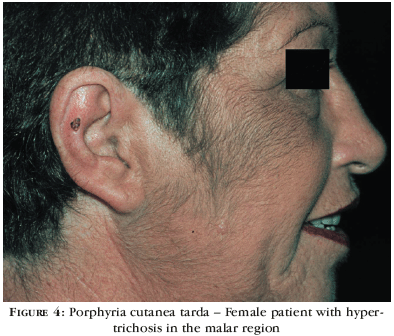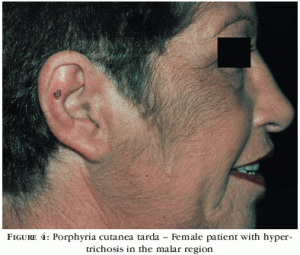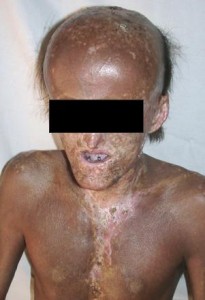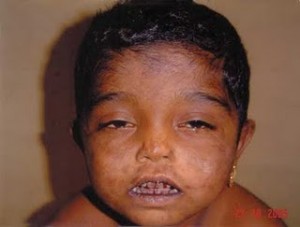Porphyria: A true story of Vampire?

In 1985 biochemist David Dolphin proposed that the vampires of folklore may actually have been people suffering from porphyria, a group of rare, largely hereditary blood diseases. According to the Times account of his remarks:
(1) Porphyria victims are extraordinarily sensitive to sunlight. Even mild exposure can cause severe disfigurement. Facial skin may scar, the nose and fingers may fall off, and the lips and gums may become so taut that the teeth project like fangs.
(2) To avoid sunlight, people with serious cases of porphyria go out only at night, just like Dracula.
(3) Today porphyria can be treated with injections of blood products. Centuries ago, porphyria victims might have sought to treat themselves by drinking blood.
(4) Porphyria is inherited, but the symptoms may not manifest themselves until brought on by stress. Suppose a sibling with an active case of the disease bites you to quench his thirst for blood. Très stressful, non? Suddenly your own latent porphyria goes critical and you start growing fangs too.
(5) Garlic contains a chemical that worsens porphyria symptoms, causing sufferers to avoid it. Just like vampires.
(6)In Porphyria, victim develops more hair over body parts and face.

Points Against the Hypothesis:
(1) Porphyria comprises seven separate disorders. Skin problems are a fairly common symptom, but only the rarest form–congenital erythropoietic porphyria–causes severe disfigurement. Just 200 cases of this disease have been diagnosed, surely too few to account for the widespread belief in vampires. In any case, alleged vampires exhumed in the 18th century typically weren’t disfigured but appeared as they had in life (except for being dead, of course).
(2) The idea that vampires abhor sunlight was an invention of fiction writers. In Europe during the 18th and 19th centuries, vampires were sometimes reported to have been sighted during the day. Bram Stoker’s Dracula was deathly pale, but folkloric vampires, in the Balkans anyway, were said to be ruddy-faced due to blood consumption.
(3) Porphyria victims don’t crave blood. Drinking blood will not alleviate their symptoms, nor has there ever been a general belief that it would. The blood chemicals porphyria victims need do not survive digestion.
(4) In light of the preceding, the scenario described in point #4 above is unlikely.
(5) No one has proved that garlic worsens porphyria.
Professor Dolphin never published a formal paper describing his theory. When I phoned, he didn’t wish to speak to me and would say only that “it was just speculation” and that “I haven’t worked in this area for many years.”
The practice of trying to match diseases with well-known figures in history or folklore has a long and not entirely reputable history. (Porphyria, for one, has also been blamed for werewolves.) Maybe next time we’ll know better.
Porphyria – the true story about Vampire
Legend tells us that vampires come out at night. They are night creatures because the sun can hurt and even kill them. They come out at night to seek fresh blood because without it they will suffer agonizing pain and will die. Their bodies dry up due to lack of blood, and new blood refreshes their bodies and gives them energy and certain powers.
It has been long believed that the condition associated with vampire legends is porphyria. Vampire characteristics are similar to those of porphyrics and this may have led to the misconception in the early 1400-1600’s that porphyria sufferers were vampires. Vampire legends are in every country and porphyria is also found throughout the world. Porphyria comes from the Greek word meaning purple.
Of course, we now know that porphyria patients are NOT vampires, but porphyria might have contributed to the origin of the vampire legends.
EXPLAINING PORPHYRIA
Porphyria is a group of disorders caused by the abnormal production of heme which is the base material responsible for making hemoglobin and chlorophyll. Most types of porphyria are inherited. A child needs to inherit the defective gene from only one parent to develop the disease.
Heme is a substance found in all body tissues. The largest amounts of heme are found in the blood and bone marrow, and heme is also found in the liver and red blood cells. Multiple enzymes are required for the body to convert chemical compounds called porphyrins into heme. If any of the enzymes are abnormal, the process is disturbed and cannot continue. This allows the porphyrins to build up in the body.
Excessive porphyrin in the body causes photosensitivity which is oversensitivity to sunlight. When porphyrins are exposed to light and oxygen, they generate a charged, unstable form of oxygen that can damage the skin. Nerve damage, pain and paralysis can occur in some porphyrias. Sometimes an attack is so severe it can also lead to respiratory paralysis and the patient is unable to speak, breath or swallow. At times, this if fatal.
ABOUT:
Congenital Erythropoietic Porphyria – Hypersensitivity to Light
Fewer than 200 cases of congenital erythropoietic porphyria have ever been documented, and not just because physicians can’t pronounce the name. Due to a gene mutation, the skin becomes extremely sensitive to sunlight. Areas of exposed skin can become blistered and infected. Sunlight exposure can also lead to scarring, changes in skin pigmentation and increased hair growth. Such symptoms have unfairly linked people suffering from the condition with the lore of vampires and werewolves. On overcast or very cold winter days, the symptoms of congenital erythropoietic porphyria (also called erythropoietic protoporphyria) are sometimes attenuated, allowing some safe exposure to indirect sunlight.
Synesthesia is not considered to be a disease (though it has not been well studied, either) and tends to affect people who are bright and colorful—er, that is, people who are intelligent and creative
Synopsis By Medchrome
Its Your Opinion Now.








3 Comments
Nice writing! Thank you. Are you okay if I ask you this question? So this is my story: My thryoid took the plunge many years ago. I unfortunately have been at the lowest dose of Synthroid as well as it keeps my TSH within normal range. Then, two years ago, I had a huge cysts in both ovaries and also both ovaries were removed. Wasn’t much time pass after that the hotflashes took control! I have 20+ hotflashes per day, thing also many hotflashes at night, have not slept well up to eighteen+ mths. Do you had any suggestion what to take?
Hot flushes are due to estrogen deficiency as a result of removal of ovaries that produce the hormone. Similar symptoms occur after Menopause.
Hormone Replacement therapies and drugs of SERM groups can help in these conditions.
Consult your Gynecologist. Surely there is a remedy.
Read more article about this on
http://metabolic-disorders.suite101.com/article.cfm/porphyria-the-disease-that-created-dracula
Comments are closed.